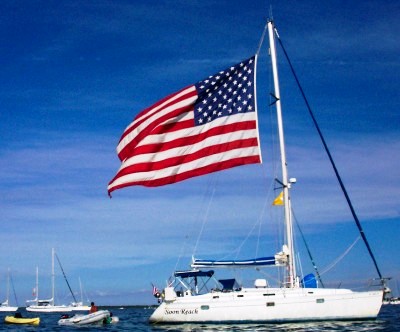
Florida Sailing
Choosing the Right Type of
Sailboat
When choosing your boat, ask
yourself, "What attracts my family and me to sailing? What do we want to
get out of sailing?"
"Off-The-Beach" - a small boat that can be thrown on
the top of your car and carried down to the beach. It's a simple and
inexpensive way to practice your sailing skills, or if you choose a
high-performance boat, to experience the buzz of riding waves or the
thrill of planning.
"Daysailor" - Boats in this free-form category
range from the cutting-edge to the traditional (centerboarders,
keelboats, or trimarans). This boat can be used for a family picnic, or
if the weather is right, an overnighter. To be a successful skipper of
this vessel, you should know the basics of sail trim, the points
of sail, the right-of-way rules, the fundamentals of anchoring, docking,
and navigation and the basics of weather.
"Coastal Cruiser" - Either a keelboat or a
multihull, should include berths and a galley, head and dining area,
auxiliary power, and the ability, via reefing systems, to get its crew
safely through windy conditions. In addition to having intermediate
sailing skills, you'll need maintenance and fix-it skills appropriate to
the equipment and systems on your boat. This is the right choice for you if
you want a boat for vacations or coastal explorations, or you want to
move up to a bluewater cruiser or a flat-out racer some day.
Strictly Sail-Miami
The sail-only portion of the
Miami International Boat Show is held each year at
Miamarina at Bayside Marketplace. More than 225 exhibitors from
around the world will display the latest sailboats, accessories and
charter information at the unique in-water and dockside show located on
Miami's Biscayne Bay. Show highlights will include seminars led by
champion sailors, test sails on exhibiting crafts, a "Learn to Sail"
program for beginners and special activities for family enjoyment. The
Bayside location will complement the excitement of the show and offer
visitors an unlimited selection of shopping, entertainment and dining
options.
Key West Race Week
Key West Race Week, held in
January, continues to attract the world's top sailors in one-design, INS
and PHRF fleets. Over 250 boats compete each year.
Tips For Safe Sailing
- Stay off the water during storms
or periods of high winds.
- Remember that the mast can be a
conductor of lighting.
- Carry a flashlight in case you
remain on the water after dark. shine the light on a sail to warn
approaching boats of your presence if you have no navigation lights
or if it appears that another boat does not see your navigation
lights.
- Remember that sailboats with an
engine must have the red, green, and white navigation lights.
- Be aware of mast clearance when
passing under power lines and bridges.
SORC
The SORC (Southern Ocean Racing
Conference) is held in February off Key Biscayne in Miami, although
ocean legs are no longer a part of this event. There are also year-round
dinghy and shoal-draft sail boat races held throughout the year, most of
them in Biscayne Bay in Miami. These events include Optimists, Lasers,
J-24's, Shields, Stars, Lightnings, Etchells, Hobie-Cats and
Windsurfers.
|

Know Your Sailboat
Use of the wind is one of the oldest forms
of powering a boat. Sailboats range in size and complexity, but all have
basically the same four components:
- The hull carries the passengers and
supports the rigging.
The rigging includes many parts of
the sailboat such as the lines (sheets and halyards), mainsail,
headsail (jib), boom and mast.
The keel or centerboard is
attached to the bottom of the hull and keeps the boat from sliding
sideways through the water.
The rudder is used to steer the
sailboat, turned by a tiller or steering wheel.
Sailing Safety
- It is always wise to give
sailboats a lot of space. Sailboats are usually the stand-on boat.
Exceptions occur when:
- The sailboat is overtaking another
boat.
- Another boat is restricted in its
ability to maneuver, for example a boat at anchor.
- The sailboat is under power.
Sailing
has its own risks that you need to take special care to avoid:
- Small sailboats are prone to
capsizing and swamping. Be prepared for these common situations.
Know how to right the boat if it capsizes and carry a bailer
onboard.
- Falling over board can be common.
For that reason sailors should always wear their PFDs and carry all
the necessary
safety equipment and clothing.
- Sailors also should remain very
aware of the water temperature. Capsizing in the early spring, fall
or winter involves the risk of hypothermia.
Life
boats and rafts should be considered for offshore excursions.
- Those interested in sailing should
take a certified course from organizations like the American Sailing
Association, the U.S. Sailing Association, and the Red Cross. Search for
Sailing Instructions.
|


